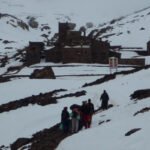Introduction to Erg Chegaga Desert
The Erg Chegaga Desert, an expansive and captivating part of the Moroccan Sahara Desert, is a testament to nature’s raw and unspoiled beauty. Located in southeastern Morocco, near the town of M’Hamid, this desert region spans over 35 kilometers in length and 15 kilometers in width, making it one of the most extensive dune systems in Morocco. Desert trekking. Its geographical coordinates place it near the Algerian border, adding a layer of remoteness that appeals to the adventurous spirit.
Desert trekking. Its geographical coordinates place it near the Algerian border, adding a layer of remoteness that appeals to the adventurous spirit.
Erg Chegaga’s dunes, some soaring up to 300 meters in height, create a stunning and ever-changing landscape that is both daunting and mesmerizing. These dunes, sculpted by the winds over centuries, form a dynamic tableau of peaks and valleys stretching endlessly into the horizon. The desert’s untouched beauty contrasts with the bustling cities and towns, providing a serene escape for those seeking solitude and a deeper connection with nature.
In the broader context of the Sahara Desert, Erg Chegaga Tours holds significant importance due to its relatively pristine condition. Unlike more frequented areas such as Erg Chebbi, Erg Chegaga remains less commercialized, preserving an authentic desert experience. This untouched aspect is a significant draw for trekkers and adventurers who yearn to explore landscapes that have remained essentially unchanged for millennia.
The allure of the Erg Chegaga Desert extends beyond its physical attributes. It represents a journey into one of the world’s most formidable environments, where the challenges of navigating the vast, arid expanse are met with the rewards of unparalleled natural beauty and tranquility. For trekkers, the desert offers a unique opportunity to experience the profound silence and majesty of the Sahara, making it a must-visit destination for those seeking both adventure and introspection.
Preparing for the Trek: Essential Gear and Supplies
Embarking through the Erg Chegaga Desert requires meticulous preparation to ensure a safe and enjoyable experience. One of the foremost considerations is the selection of appropriate clothing. Lightweight, breathable, and moisture-wicking fabrics are crucial to combat the intense heat. Opt for long sleeves and pants to protect your skin from the sun’s harsh rays and minimize insect exposure. A wide-brimmed hat and UV-protective sunglasses shield your face and eyes.
Footwear is another critical component. Sturdy, well-fitted hiking boots with good ankle support are essential to navigate the rugged desert terrain. Don’t forget to bring extra pairs of moisture-wicking socks to keep your feet dry and prevent blisters. Camping in the Erg Chegaga Desert necessitates reliable camping equipment. A lightweight, durable tent that can withstand the desert winds, along with a high-quality sleeping bag rated for desert temperatures, will ensure restful nights. A compact, portable cooking stove and utensils are also key for preparing meals.
Hydration is paramount in the desert environment. Carrying an ample water supply is non-negotiable; consider a hydration pack and additional water bottles. Electrolyte supplements can help maintain your body’s salt balance. Sun protection is equally vital; high-SPF sunscreen and lip balm will guard against sunburn and chapped lips.
Navigation tools such as a reliable map, compass, and GPS device are essential for staying on course in the vast desert expanse. Modern trekkers might also benefit from satellite communication devices for emergencies. It’s also wise to have a basic first aid kit equipped with bandages, antiseptics, and personal medications.
Physical preparation is crucial for enduring the demanding conditions of the Erg Chegaga Desert. Engage in regular cardiovascular and strength training exercises to build stamina and resilience. Practice hiking with a loaded backpack to simulate the trekking experience. This preparation will enhance your physical readiness and boost your confidence as you venture into the awe-inspiring landscapes of the Erg Chegaga Desert.
Understanding the Local Climate and Best Time to Visit
The Erg Chegaga Desert, located in the southeastern part of Morocco, presents a unique climate characterized by significant temperature variations and challenging weather conditions. Understanding these climatic nuances is crucial for trekkers planning their adventure in this expansive desert landscape.
Temperature fluctuations in the Erg Chegaga Desert are stark. During the summer months, from June to August, daytime temperatures can soar above 45°C (113°F), creating extreme conditions that can be perilous for unprepared visitors. Conversely, the winter months, from December to February, witness a substantial drop in temperature, with nighttime lows occasionally dipping below 0°C (32°F). These dramatic temperature swings necessitate careful planning and appropriate gear to ensure a safe and comfortable trekking experience.
Wind conditions in the Erg Chegaga Desert also significantly shape the trekking experience. Known for its fierce and unpredictable winds, the region can experience sudden sandstorms, particularly during the spring months of March to May. These locally called “chergui” sandstorms can reduce visibility and make navigation challenging. Trekkers should stay informed about weather forecasts and be prepared to adjust their plans if necessary.
The best time to visit the Erg Chegaga Desert for trekking is during the shoulder seasons of spring and autumn. From March to May and September to November, the temperatures are more moderate, ranging between 20°C (68°F) and 30°C (86°F) during the day, with cooler nights. These conditions provide a more manageable and enjoyable trekking environment. Additionally, spring brings the occasional bloom of desert flowers, adding a touch of color to the otherwise arid landscape.
Notable events and festivals also coincide with these optimal trekking seasons. One such event is the annual Nomad Festival, typically held in March. This festival celebrates the rich cultural heritage of the region’s nomadic tribes. It offers trekkers a unique opportunity to immerse themselves in local traditions, music, and cuisine, enhancing the overall trekking experience in the Erg Chegaga Desert.
Navigating the Desert: Routes and Landmarks
Embarking on a journey through the Erg Chegaga Desert offers trekkers a unique blend of adventure and natural beauty. The desert, known for its vast sand dunes and remote landscapes, presents several trekking routes catering to different levels of experience and fitness. best time to visit Erg Chegaga.
One of the most popular routes begins at M’Hamid, a small oasis town that serves as the gateway to the Erg Chegaga Desert. Trekkers often start here, heading towards the dunes for a journey that typically spans three to four days. This route is moderately challenging, with distances averaging 15-20 kilometers per day. Key landmarks along this trail include the sacred oasis of Oued Naam and the picturesque Bougarn Dunes, which offer stunning sunrise and sunset views in the Luxury Camp in Erg Chegaga.
For those seeking a more challenging experience, the route from Foum Zguid to Erg Chegaga is highly recommended. This trek usually takes five to six days and covers a distance of approximately 100 kilometers. The terrain is more rugged, with trekkers navigating through sandy and rocky landscapes. Highlights of this route include the expansive Iriki Lake, a dry lakebed that creates an otherworldly panorama, and the impressive height of the Erg Chegaga Dunes, which reach up to 300 meters.
The Erg Chegaga Desert is also dotted with notable natural formations and oases that provide much-needed respite for weary travelers. The Ait Oumir Oasis, with its lush palm groves, is a prominent stop for many trekking routes. Cultural sites, such as the remnants of ancient caravanserais, offer glimpses into the region’s rich history and its role in trans-Saharan trade.
Effective route planning is crucial for a successful trek. Trekkers should consider the distances and difficulty levels of their chosen paths and allocate sufficient time for rest and exploration. Local guides with deep knowledge of the terrain and landmarks can significantly enhance the experience, ensuring a safe and enriching journey through the mesmerizing Erg Chegaga Desert.
Cultural Encounters: Connecting with the Nomadic Tribes
Beyond its mesmerizing landscapes, the Erg Chegaga Desert offers trekkers a unique opportunity to immerse themselves in the rich cultural tapestry of the nomadic tribes that call this arid region home. Living in harmony with the harsh desert environment, these tribes, primarily the Berbers and Tuaregs, have developed distinctive customs and traditions that thrive in modern times.
Understanding the way of life of the nomadic tribes involves appreciating their deep connection to the desert. Their livelihood revolves around herding livestock, such as camels, goats, and sheep, which are well-suited to the arid climate. The nomads’ intricate knowledge of the desert’s resources, such as water sources and medicinal plants, is passed down through generations, making them adept survivors in an unforgiving landscape.
When trekking through the Erg Chegaga Desert, it is essential to approach the nomadic tribes with respect and sensitivity. Observing their cultural norms, such as dressing modestly and requesting permission before taking photographs, demonstrates courtesy and fosters positive interactions. Engaging with the nomads can reveal insights into their daily routines, traditional music, and storytelling practices, which are often shared around communal campfires.
Opportunities for cultural exchange abound, ranging from participating in traditional tea ceremonies to learning about the art of desert navigation. Many nomadic families are open to sharing their hospitality with trekkers, offering authentic experiences such as staying in traditional tents (known as “Khaimas”) and savoring local cuisine. These encounters enrich the trekking experience and support the preservation of the nomads’ cultural heritage.
Ultimately, connecting with the nomadic tribes of the Erg Chegaga Desert offers a profound understanding of resilience and adaptability. It bridges the gap between past and present, providing trekkers with a deeper appreciation of the desert’s human element and the timeless traditions that continue to define the nomadic way of life.
Flora and Fauna: Discovering Desert Biodiversity
The Erg Chegaga Desert, often perceived as a barren expanse, is surprisingly rich in flora and fauna. This arid environment hosts a variety of plant and animal species, each uniquely adapted to survive the harsh conditions. Among the plant life, one commonly encounters the resilient Tamarisk, a shrub that thrives in saline soils and can withstand prolonged droughts. Another notable species is the Acacia tree, whose deep root systems allow it to tap into subterranean water sources, thus supporting the desert ecosystem.
Cacti, such as the Prickly Pear, are also prevalent. Their thick, fleshy pads store water to endure prolonged dry spells. These plants symbolize survival and play a crucial role in preventing soil erosion, anchoring the sand in place with their extensive root networks. As trekkers traverse the Erg Chegaga, they may also notice the delicate Desert Hyacinth, a parasitic plant that derives nutrients from the roots of other desert flora.
The fauna of Erg Chegaga is equally fascinating. The Fennec Fox, with its large ears and nocturnal habits, is a quintessential desert dweller. Its ears dissipate heat and enhance hearing, aiding in the hunt for insects and small mammals. Another remarkable inhabitant is the Dorcas Gazelle, known for its ability to go without water for extended periods, deriving moisture from the plants it consumes. The adaptability of these creatures is a testament to the desert’s unique biodiversity.
Bird enthusiasts might spot the Desert Sparrow or the majestic Golden Eagle, both of which have adapted to the sparse vegetation and extreme temperatures. Reptiles like the horned viper and the desert monitor lizard also make their home here, their physiological traits enabling them to thrive where few other creatures can.
Conservation efforts are in place to protect this delicate ecosystem. Various NGOs and governmental bodies are working to preserve the biodiversity of Erg Chegaga. Efforts include establishing protected areas, promoting sustainable tourism, and conducting research to better understand the ecological dynamics of this unique desert landscape. For trekkers, this means not only exploring a region of stark beauty but also contributing to its preservation through responsible travel practices.
Safety Tips and Precautions for Desert Trekking
Trekking in the Erg Chegaga Desert presents a unique and exhilarating experience, but it also comes with its share of risks that require careful preparation and knowledge. One of the primary hazards trekkers face is extreme temperatures. The desert climate can fluctuate drastically, with sweltering heat during the day and freezing cold at night. It is essential to dress in layers and wear appropriate sun protection, such as hats, sunglasses, and high-SPF sunscreen. Lightweight, breathable clothing that covers the skin can also help protect against the sun’s intense rays.
Dehydration is another significant concern in the Erg Chegaga Desert. Trekkers should carry a sufficient supply of water, aiming for at least three liters per person per day. It’s advisable to use hydration packs and water bottles that are easily accessible. Additionally, bringing electrolyte supplements can help maintain the body’s salt balance, which is crucial when sweating heavily.
Navigation challenges are common in the vast, seemingly uniform landscape of the Erg Chegaga Desert. Trekkers should use reliable navigation tools, such
as GPS devices and detailed maps. It is also beneficial to learn basic desert navigation skills and recognize landmarks that can assist in maintaining the correct path. In disorientation, staying calm, avoiding wandering aimlessly, and conserving energy while waiting for help is critical.
Emergency procedures should be well understood before embarking on a trek. Trekkers must know how to signal for help, whether through satellite phones, flares, or mirrors. Sharing an itinerary with a trusted contact who is not part of the trek can also ensure that someone is aware of the group’s location and expected return time. Communication methods should be reliable, and it is highly recommended to travel with a satellite phone, especially in areas with no cellular coverage.
Lastly, the importance of traveling in groups or with experienced guides cannot be overstated. Group travel enhances safety by providing mutual support, and experienced guides bring invaluable knowledge of the terrain and survival skills. They can offer insights into local weather patterns, wildlife, and emergency protocols, significantly increasing the chances of a safe and enjoyable trek.
Capturing the Adventure: Photography Tips for the Erg Chegaga Desert
Embarking on a trek through the Erg Chegaga Desert offers a unique opportunity to capture some of the most breathtaking landscapes and moments. To effectively document this adventure, it’s crucial to understand the specific challenges and techniques pertinent to desert photography. The vastness and beauty of the dunes provide a stunning backdrop, but they also present unique lighting conditions and environmental hazards that must be navigated with care.
Firstly, the desert’s lighting conditions can be harsh and ever-changing. The best times for photography are during the golden hours—shortly after sunrise and just before sunset. During these periods, the light is softer, and the shadows are longer, adding depth and contrast to your images. Midday sun, on the other hand, can produce harsh shadows and overexposed highlights. Using a polarizing filter can help manage the brightness and enhance the colors of the sky and sand.
Protecting your equipment from the pervasive sand is another essential consideration. Sand can easily infiltrate camera bodies and lenses, causing significant damage. To mitigate this, use a camera rain cover or a plastic bag with a hole cut for the lens. Additionally, avoid changing lenses in windy conditions to prevent sand from entering your camera. Regularly clean your equipment with a blower brush to remove any sand particles.
When composing your shots, aim to highlight the vastness and beauty of the Erg Chegaga dunes. Wide-angle lenses are particularly effective for capturing the expansive landscapes. Incorporate elements such as footprints, shadows, or the occasional vegetation to add scale and context to your images. The interplay of light and shadow on the undulating dunes can create captivating patterns and textures.
While capturing the beauty of the Erg Chegaga Desert, it is also essential to be mindful of the environment and local culture. Avoid disturbing the natural habitat and respect any local customs and traditions. Engage with the local community where appropriate, and seek permission before photographing people or cultural sites.
By following these photography tips, trekkers can document their journey through the Erg Chegaga Desert with images that truly reflect its awe-inspiring beauty and unique experiences.






